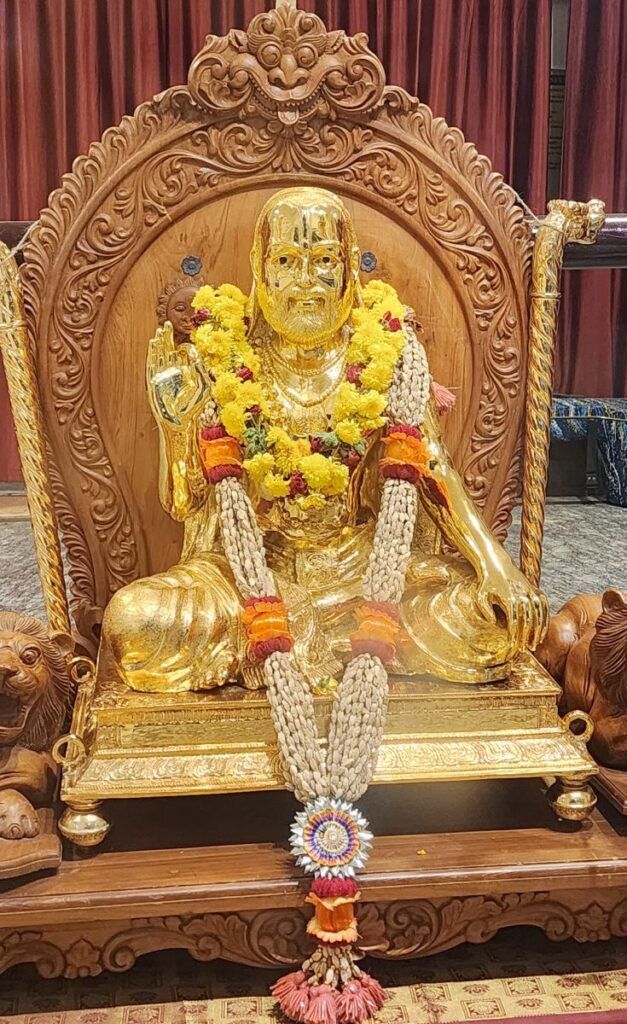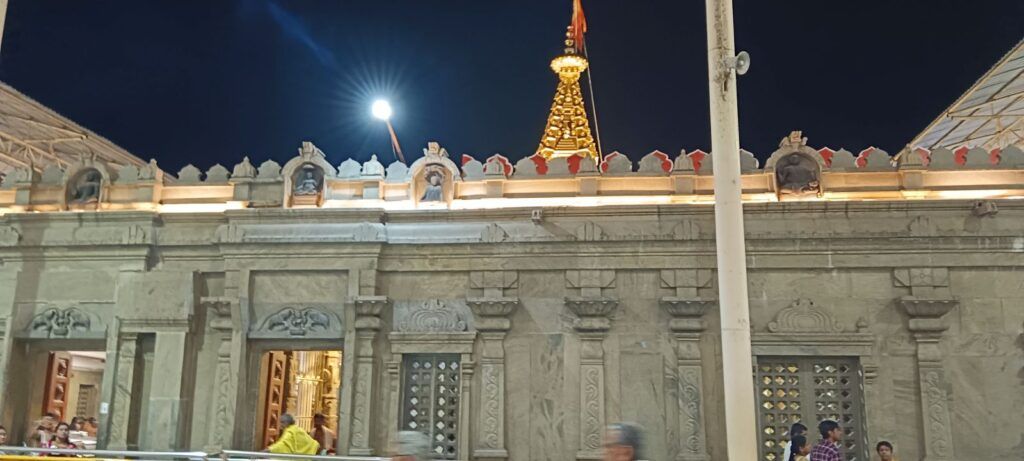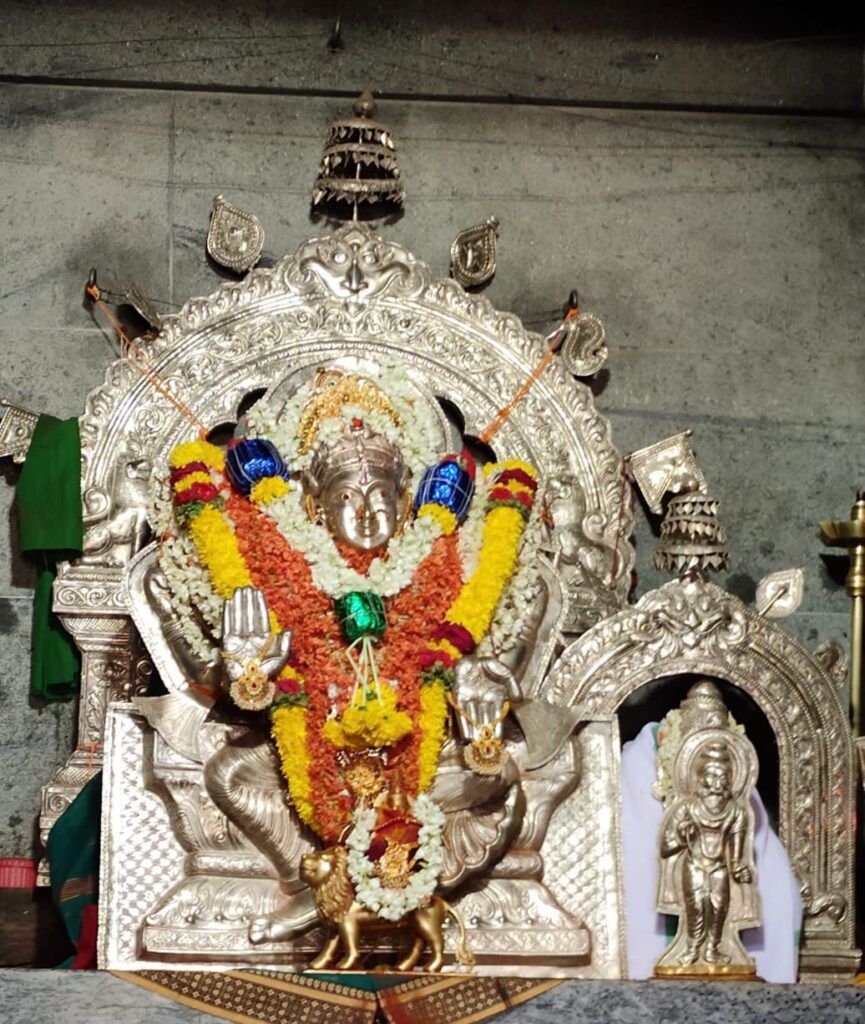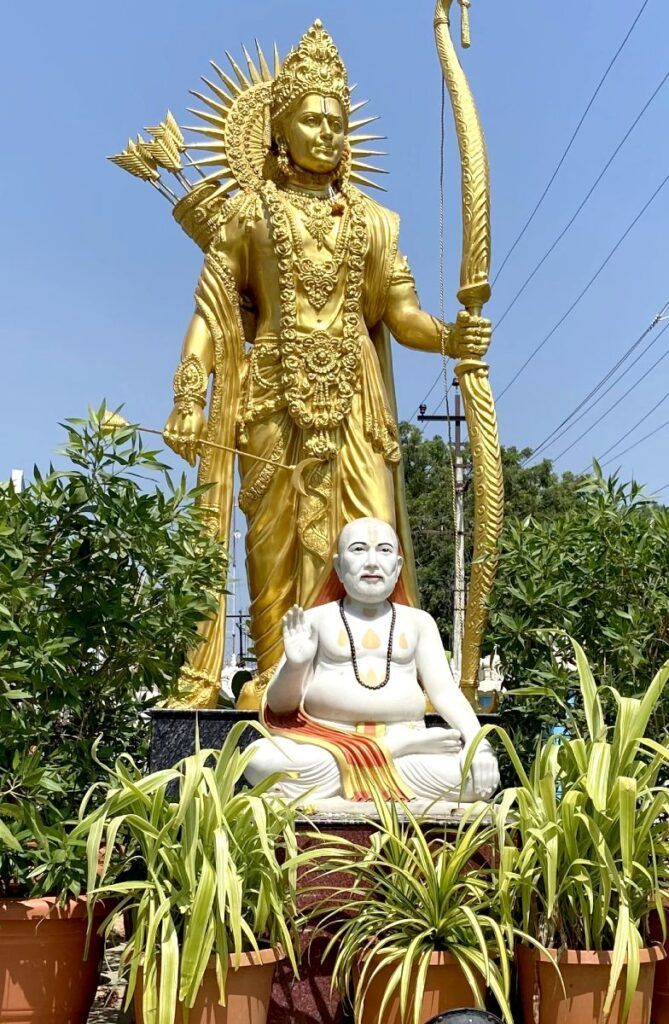Raghavendra Swamy Temple Mantralayam
The Raghavendra Swamy Temple is a large riverside temple complex with stone carvings and daily rituals, dedicated to a Hindu saint. It is located in Mantralayam, Andhra Pradesh, India. The temple is one of the most important pilgrimage sites for Hindus, and it is especially popular among followers of the Dvaita Vedanta school of thought.

Contents
- 1 History of Raghavendra Swamy Temple Mantralayam:
- 2 Significance of Raghavendra Swamy Temple Mantralayam:
- 3 Legend of Raghavendra Swamy Temple Mantralayam:
- 4 Architecture of Raghavendra Swamy Temple Mantralayam:
- 5 Myths of Raghavendra Swamy Temple Mantralayam:
- 6 Miracles of Raghavendra Swamy Temple Mantralayam:
- 7 Specialty of Raghavendra Swamy Temple Mantralayam:
- 8 Mantralayam Temple Timings:
- 9 Places to visit near Raghavendra Swamy Temple Mantralayam:
- 10 FAQ:
- 11 How to reach Raghavendra Swamy Temple Mantralayam:
- 12 Google Maps:
History of Raghavendra Swamy Temple Mantralayam:
The Raghavendra Swamy Temple in Mantralayam, Andhra Pradesh, India is a Hindu pilgrimage site dedicated to Raghavendra Swamy, a saint who lived in the 17th century. Raghavendra Swamy was a scholar and theologian who wrote extensively on the Dvaita philosophy of Hinduism. He was also a powerful miracle worker, and his devotees believe that he is still alive today, meditating in a cave beneath the temple.
The history of the Raghavendra Swamy Temple dates back to the 17th century, when Raghavendra Swamy came to Mantralayam. He was initially reluctant to stay in Mantralayam, but he was persuaded by the locals to do so. Raghavendra Swamy spent many years in Mantralayam, teaching and preaching the Dvaita philosophy. He also performed many miracles, which helped to spread his fame far and wide.
In 1671, Raghavendra Swamy decided to enter into samadhi, or a state of deep meditation. He asked his disciples to build a brindavana (tomb) for him, and he entered into samadhi on the banks of the Tungabhadra River. His disciples built a brindavana over his tomb, and the Raghavendra Swamy Temple was built around the brindavana.
The Raghavendra Swamy Temple is a popular pilgrimage site for Hindus from all over India. Devotees come to the temple to worship Raghavendra Swamy and to seek his blessings. The temple is also a major tourist attraction, and visitors from all over the world come to see the Mantralayam temple and to learn about the life of Raghavendra Swamy.
Explore More Temples>> Shirdi Sai Baba Temple Maharashtra
Significance of Raghavendra Swamy Temple Mantralayam:
Sri Raghavendra Swamy was a scholar, philosopher, and teacher. He was also a powerful miracle worker. He was known for his compassion and kindness, and he helped people from all walks of life.
Sri Raghavendra Swamy is said to have entered into jeeva samadhi, or conscious samadhi, in 1671. He is believed to be still present in his Brindavana (final resting place) at the Mantralayam temple.
Devotees from all over India and the world come to the Mantralayam temple to seek Sri Raghavendra Swamy’s blessings. They believe that he can answer their prayers and solve their problems.
The Raghavendra Swamy Temple is also a major center for learning and scholarship. The temple has a library that houses a vast collection of ancient manuscripts and texts. The Mantralayam temple also has a school that teaches Sanskrit and other Hindu scriptures.
The Raghavendra Swamy Temple is a place of great spiritual significance. It is a place where people come to find peace, solace, and guidance.
Explore More Temples>> Tripura Sundari Temple in Tripura

Legend of Raghavendra Swamy Temple Mantralayam:
The legend of the Raghavendra Swamy Temple in Mantralayam is a fascinating one. It is said that Raghavendra Swamy, a revered Hindu saint, lived in the temple complex for many years and eventually attained samadhi, or the state of liberation, there in 1671.
One of the most popular legends about the temple is that of the miraculous appearance of a Brindavanam, or sacred grove, around the temple complex. It is said that Raghavendra Swamy himself planted the trees in the Brindavanam, and that the trees grew miraculously overnight. The Brindavanam is now a popular pilgrimage site for devotees, who come to pray and meditate there.
Another popular legend about the Mantralayam temple is that of the miraculous healing of a sick child. It is said that a couple once brought their sick child to the temple to seek Raghavendra Swamy’s blessings. Raghavendra Swamy sprinkled holy water on the child, and the child was immediately healed. This legend is said to be a testament to Raghavendra Swamy’s miraculous powers and his compassion for his devotees.
The Raghavendra Swamy Temple is also known for its many other miracles. Devotees have reported experiencing a wide range of miracles, from healing of illnesses to financial success to academic achievement. The temple is a place of great faith and devotion, and it attracts visitors from all over the world.
Here are some specific examples of miracles that are said to have occurred at the Raghavendra Swamy Temple:
- A man who was suffering from a terminal illness was cured after visiting the temple.
- A woman who was unable to conceive a child was blessed with a child after praying at the temple.
- A student who was struggling in school suddenly excelled in his studies after visiting the temple.
- A family that was facing financial ruin was suddenly blessed with prosperity after praying at the Mantralayam temple.
- A couple who were having marital problems was able to reconcile after visiting the temple.
Explore More Temples>> Katyayani Shakti Peeth Vrindavan

Architecture of Raghavendra Swamy Temple Mantralayam:
The temple’s architecture follows a traditional South Indian temple style, and here are some key architectural features:
Gopuram: The temple features a prominent gopuram (tower) at the entrance. Gopurams are typical of South Indian temple architecture and are highly decorative and ornate, often adorned with intricate sculptures and carvings.
Mandapa: The temple has a large central hall or mandapa where devotees gather for prayer and rituals. This hall is often supported by ornate pillars and serves as a congregation area.
Sanctum Sanctorum: The main sanctum sanctorum of the temple houses the deity of Raghavendra Swamy. The sanctum is typically adorned with rich decorations, including gold and silver ornaments, and devotees offer prayers and offerings in this sacred space.
Sannidhi: Apart from the main deity, there are smaller shrines or sannidhis within the temple complex dedicated to other gods and goddesses. These sannidhis can include deities like Lord Hanuman, Lord Venkateswara, and others.
Prakara: The temple is enclosed by a prakara or compound wall. The walls often have intricate carvings, and there are entrances at different points around the temple complex.
Gardens and Courtyards: Many South Indian temples, including the Raghavendra Swamy Temple, feature well-maintained gardens and courtyards where devotees can sit, relax, and partake in religious activities.
Raja Gopuram: This is the main tower or gopuram that is often the tallest and most grandiose structure in the temple complex. It is typically visible from a distance and serves as a landmark.
Acharya Peetha: There is a special seat or peetha for the Acharya, representing the spiritual leader of the matha (religious institution) associated with the temple.
Halls for Devotees: The temple often has halls for devotees to rest and dine, especially for those who come from far-off places.
Kalyana Mandapam: Some temples have a separate hall for conducting religious marriages and ceremonies.
Explore More Temples>> Anandamayee Shakti Peeth Temple

Myths of Raghavendra Swamy Temple Mantralayam:
One of the most famous myths associated with the Raghavendra Swamy Temple is the story of the saint’s jeeva samadhi. Jeeva samadhi is a state of deep meditation in which the person’s body is said to be still alive, but their consciousness has left the body. It is believed that Sri Raghavendra Swamy entered jeeva samadhi in 1671 AD and is still alive inside his samadhi chamber at the temple.
Another myth associated with the Mantralayam temple is the belief that Sri Raghavendra Swamy continues to bless his devotees even after his death. Devotees come to the temple to pray for their wishes to be fulfilled, and many believe that their prayers have been answered through the grace of the saint.
Here are some of the specific myths associated with the Raghavendra Swamy Temple:
- The myth of the talking idol: It is believed that the idol of Sri Raghavendra Swamy in the temple speaks to his devotees. Devotees often claim to have heard the saint’s voice giving them advice or guidance.
- The myth of the healing water: The water from the well at the temple is believed to have healing powers. Devotees often drink the water or bathe in it in order to cure their ailments.
- The myth of the disappearing food: It is believed that the food that is offered to the idol of Sri Raghavendra Swamy disappears miraculously. Devotees believe that the saint accepts the food and consumes it.
- The myth of the protective aura: It is believed that the Raghavendra Swamy Temple has a protective aura around it. Devotees believe that the saint protects them from all harm as long as they are within the temple complex.
Explore More Temples>> Subramanya Swamy Temple at Tiruttani
Miracles of Raghavendra Swamy Temple Mantralayam:
Here are some of the miracles that are said to have happened at the Raghavendra Swamy Temple:
- A woman who was unable to conceive for many years was blessed with a child after visiting the temple.
- A man who was diagnosed with a terminal illness was cured after praying at the temple.
- A family who was facing financial hardship was able to overcome their problems after visiting the temple.
- A student who was struggling in school was able to achieve academic success after visiting the temple.
- A farmer who was facing crop failure was blessed with a bountiful harvest after visiting the temple.
These are just a few examples of the many miracles that are said to have happened at the Raghavendra Swamy Temple. Devotees believe that Raghavendra Swamy is always listening to their prayers and is always there to help them.
Here is a specific story of a miracle that is said to have happened at the Raghavendra Swamy Temple:
A young man was traveling on a train when he was attacked by robbers. The robbers stole all of his belongings and left him for dead. The young man was badly injured and was unable to move. He prayed to Raghavendra Swamy for help.
Suddenly, a bright light appeared in the compartment. The light surrounded the young man and healed his injuries. The young man was able to get to his feet and run away from the train. He knew that Raghavendra Swamy had saved his life.
Devotees believe that Raghavendra Swamy is a living saint who is always ready to help those who are in need. They come to the Mantralayam temple to seek his blessings and to experience his miracles.
Explore More Temples>> Enchanting Beauty of Madurai Meenakshi Amman Temple

Specialty of Raghavendra Swamy Temple Mantralayam:
Here are some of the special things about the Raghavendra Swamy Temple:
- The jeeva samadhi: Sri Raghavendra Swamy is said to have entered into jeeva samadhi, or a state of deep meditation, in the year 1671. His jeeva samadhi is located in the temple complex, and devotees come from all over the world to seek his blessings.
- The miracle of the moola brindavana: The moola brindavana is the main shrine in the temple complex, and it is where the jeeva samadhi of Sri Raghavendra Swamy is located. It is said that the moola brindavana is a place where miracles happen. Devotees have reported being cured of illnesses, receiving financial blessings, and achieving success in their careers after visiting the moola brindavana.
- The power of prayer: The Raghavendra Swamy Temple is a place where prayers are answered. Devotees come to the temple to pray for their loved ones, for their own well-being, and for their spiritual growth. It is said that Sri Raghavendra Swamy listens to the prayers of his devotees and helps them to achieve their desires.
- The sense of peace and serenity: The Raghavendra Swamy Temple is a place where people come to find peace and serenity. The Mantralayam temple complex is surrounded by lush green trees and the tranquil Tungabhadra River. The atmosphere in the temple is one of devotion and spirituality.
Explore More Temples>> Golden Temple, Amritsar (Harmandir Sahib) | Complete Guide
Mantralayam Temple Timings:
- Morning Darshan:
- The temple usually opens for morning darshan (worship) around 4:00 AM.
- Morning rituals and aarti take place during this time.
- Noon Darshan:
- The temple remains open during the afternoon hours.
- Noon darshan typically starts around 12:00 PM and continues until around 2:00 PM.
- Evening Darshan:
- The temple reopens in the evening for the final darshan.
- Evening darshan usually begins around 4:00 PM and continues until around 8:00 PM.
Places to visit near Raghavendra Swamy Temple Mantralayam:
Raghavendra Swamy Temple: The main attraction in Mantralayam is the Raghavendra Swamy Temple itself. Devotees come from far and wide to visit this temple and seek the blessings of Raghavendra Swamy.
Panchamukhi Anjaneya Temple: This temple is dedicated to Lord Hanuman and is located a short distance from the Raghavendra Swamy Temple. It’s famous for the five-faced idol of Lord Hanuman, which is quite unique.
Manchalamma Temple: This temple is dedicated to Manchalamma, the village deity of Mantralayam. It’s a popular spot for devotees and is known for its vibrant and colorful architecture.
Tungabhadra River: The Tungabhadra River flows near Mantralayam and offers a peaceful environment for devotees to take a dip and perform religious rituals.
Alampur: Alampur, located around 26 kilometers from Mantralayam, is famous for its Nava Brahma temples, which are dedicated to Lord Shiva. It’s an important historical and architectural site.
Kurnool: Kurnool, a city about 74 kilometers away from Mantralayam, has several attractions, including the Kurnool Fort, Belum Caves, and Oravakallu Rock Garden.
Adoni: Adoni, which is approximately 50 kilometers from Mantralayam, has historical sites such as the Adoni Fort and the Jumma Masjid.
Yaganti Temple: Yaganti, around 100 kilometers from Mantralayam, is known for the Yaganti Temple, dedicated to Lord Shiva. The temple is famous for its unique idol of Nandi (the sacred bull).
Ahobilam: Ahobilam, located about 150 kilometers from Mantralayam, is another important pilgrimage site known for the Ahobilam Temple Complex, dedicated to Lord Narasimha.
Kadapa: Kadapa, which is around 190 kilometers away, offers attractions like the Ameen Peer Dargah and Gandikota Fort.
Explore More Temples>> Brihadeeswarar Temple: Timeless Marvel of Chola Architecture

FAQ:
Q: Where is the Raghavendra Swamy Temple located?
A: The Raghavendra Swamy Temple is located in Mantralayam, Kurnool district, Andhra Pradesh, India. Mantralayam is about 150 kilometers from Kurnool and about 300 kilometers from Hyderabad.
Q: What is the Raghavendra Swamy Temple dedicated to?
A: The Raghavendra Swamy Temple is dedicated to Sri Raghavendra Swamy, a revered Hindu saint and philosopher. Sri Raghavendra Swamy was the pontiff of the Madhva Matha for close to 50 years. He is known for his miracles and his teachings on the Dvaita school of Hindu philosophy.
Q: What is the history of the Raghavendra Swamy Temple?
A: Sri Raghavendra Swamy entered into a state of Samadhi (conscious transcendence) in the year 1671 AD. His mortal remains are enshrined in the Brindavana (samadhi) at the Raghavendra Swamy Temple. The Mantralayam temple was built in the 17th century by Sri Raghavendra Swamy’s disciples.
Q: What are the timings of the Raghavendra Swamy Temple?
A: The Raghavendra Swamy Temple is open from 6:00 AM to 12:00 PM and from 4:00 PM to 9:00 PM.
Q: What are the rituals performed at the Raghavendra Swamy Temple?
A: The Raghavendra Swamy Temple is a major pilgrimage site for Hindus. Devotees come to the temple to worship Sri Raghavendra Swamy and to participate in the various rituals that are performed there. These rituals include pujas, aartis, and bhajans.
Q: What are the dress codes for the Raghavendra Swamy Temple?
A: Dress codes for the Raghavendra Swamy Temple are as follows:
- Men are required to wear a dhoti or pyjama, and a shirt or kurta.
- Women are required to wear a saree or a salwar kameez.
- Shoes are not allowed inside the temple.
Q: What are the facilities available at the Raghavendra Swamy Temple?
A: The Raghavendra Swamy Temple has a number of facilities available for visitors, including:
- A guesthouse
- A canteen
- A library
- A museum
- A parking lot
Q: What are the tips for visiting the Raghavendra Swamy Temple?
A: Here are some tips for visiting the Raghavendra Swamy Temple:
- Dress appropriately.
- Remove your shoes before entering the temple.
- Be respectful of the Mantralayam temple and its customs.
- Follow the instructions of the temple staff.
Q: What are the things to see and do in Mantralayam?
A: In addition to the Raghavendra Swamy Temple, there are a number of other things to see and do in Mantralayam, including:
- The Panchamukhi Hanuman Temple: This temple is dedicated to Lord Hanuman, the monkey god.
- The Sri Prasanna Venkateswara Swamy Temple: This temple is dedicated to Lord Venkateswara, an avatar of Lord Vishnu.
- The Sri Mutt: This is the headquarters of the Madhva Matha.
- The Brindavana: This is the samadhi of Sri Raghavendra Swamy.
- The Tungabhadra River: This river flows through Mantralayam and is considered to be sacred.
How to reach Raghavendra Swamy Temple Mantralayam:
By Air:
The nearest airport to Mantralayam is the Rajiv Gandhi International Airport in Hyderabad, which is approximately 250 kilometers away. After reaching Hyderabad, you can choose to travel by road to Mantralayam via bus, taxi, or a combination of both.
By Train:
Mantralayam has its own railway station called Mantralayam Road (station code: MALM). It is well-connected to various major cities in India, including Hyderabad, Bangalore, and Chennai. You can check the Indian Railways website for train schedules and book your tickets in advance. The Mantralayam Road railway station is quite close to the Raghavendra Swamy Temple.
By Road:
From Hyderabad: You can take a bus or drive to Mantralayam from Hyderabad. The distance is approximately 250 kilometers, and it takes around 5-6 hours by road. You can follow National Highway 44 (NH44) to reach Mantralayam from Hyderabad.
From Bangalore: If you’re coming from Bangalore, the distance to Mantralayam temple is around 360 kilometers, and it usually takes about 7-8 hours to reach by road. You can take NH44, which connects Bangalore to Mantralayam.
From Chennai: Mantralayam is approximately 440 kilometers from Chennai, and the journey can take around 8-9 hours by road. You can follow NH38 and NH44 to reach your destination.
For accommodation and seva tickets visit Mantralayam Temple Official Website.

One Comment